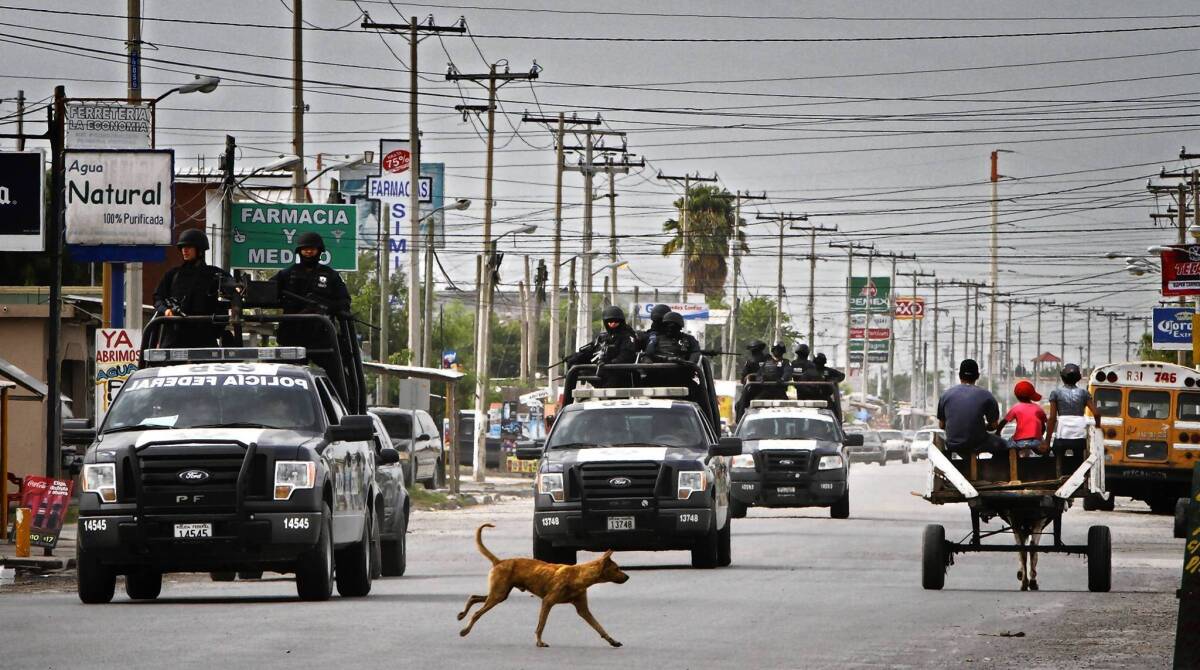U.S.-Mexico drug war partnership under Calderon broke new ground

MEXICO CITY — In the six years of outgoing President Felipe Calderon’s war against drug gangs, the U.S. became a principal player in Mexico, sending drones and sniffer dogs, police trainers and intelligence agents to a country long suspicious of its powerful neighbor.
Calderon, who steps down Saturday, essentially rewrote the rules under which foreign forces could act here in matters of national security. There has been relatively little public protest, reflecting the severity of a conflict that has killed tens of thousands nationwide and spread violence south into Central America — without significantly reducing the flow of drugs.
Incoming President Enrique Peña Nieto, whose Institutional Revolutionary Party long embodied a vocal Mexican nationalism, has said he wants to maintain cooperation with the United States at a high level, although he is suggesting some policy shifts.
FULL COVERAGE: Mexico Under Siege
U.S. intelligence has led to some of Calderon’s biggest successes, the killing or arrest of several key drug capos. At a more modest level, U.S. trainers are teaching Mexico’s notoriously corrupt police how to fill out reports and collect evidence. American military officers sit side by side with Mexican navy counterparts planning and monitoring operations from classified centers.
But the United States also has at times been sucked into relationships with security agencies that have been accused of serious human rights abuses. A number of embarrassments, including the shooting by Mexican police of CIA operatives and a fatal attack on civilians by Honduras forces aided by U.S. agents, have highlighted some of the failings of the multibillion-dollar effort. In both cases, local forces involved had received U.S. money, vetting and training.
The military, once one of Mexico’s respected institutions, has committed numerous abuses, including torturing detainees and killing innocent people.
Overall, however, officials and experts on both sides praise the cooperation.
“The relationship [with Mexico] is at an all-time high,” a top U.S. law enforcement official based in Mexico said in an interview. “There is a partnership across the board, and it is extremely effective.”
“It is huge,” said a senior U.S. military officer based until recently in Mexico. “I’ve seen a sea change in just the last three years, more or less.”
Since Calderon took office six years ago, Washington has pumped more than $2 billion into Mexico’s drug war and discreetly deployed hundreds of operatives from the CIA, the Treasury and Justice departments and the FBI, as well as retired cops and judges.
They have spilled over from the U.S. Embassy building on Mexico City’s graceful Reforma Boulevard to the 21st floor of a glass-sheathed high-rise a block away. The so-called Bilateral Implementation Office is a tidy, carpeted nest of cubicles and meeting rooms with pea-green walls that the Mexican newsweekly Proceso recently put on its cover and branded as an “espionage center.”
As Calderon’s forces have worked with the Americans to take on the powerful Sinaloa, Gulf and Zeta cartels, among others, many of these have moved steadily into Central America, an area historically more susceptible to U.S. intervention. That has prompted the United States to expand its presence there as well.
In Mexico, the U.S. expansion represents a cultural shift. History is replete with U.S. meddling. Mexican law, rhetoric and sentiment have long rejected any hint of foreign interference.
Calderon’s strategy had been widely criticized at home, but more for how he has executed it. The drug war has left an enormous toll of dead, abused and missing, even while cartel dominance has extended to wide swaths of Mexican territory.
The public acceptance of U.S. involvement in the crackdown is largely the result of awareness of how dire the threat from cartels is, and how ill-equipped Mexican forces are to fight them.
“Mexican political culture has changed in recent decades,” said Eduardo Guerrero, a security expert at a Mexico City consulting firm. “Especially with the free-trade agreement, we see the U.S. as more of a partner.”
Guerrero said U.S. intelligence was a game-changer in the drug war. “The American intelligence systems are simply more potent than the Mexican ones,” he said.
Mexican naval special forces and a corps of specially vetted federal police units have proved most ready to put aside anti-U.S. sentiment to work closely with the Americans. Other organizations, like the hidebound, top-heavy army, have been slower to come around, say current and former U.S. officials and Mexican analysts.
U.S. officials have had to adjust as well, overcoming deep mistrust of their Mexican partners to focus on those vetted units and consult regularly with Calderon’s security chief, Genaro Garcia Luna.
Yet the old ghosts pop up periodically. Mexican federal police agents in civilian attire and unmarked cars in August ambushed two American CIA operatives riding south of Mexico City in an SUV with diplomatic license plates. They pumped 152 bullets into it before the navy intervened and rescued the Americans.
The incident sent chills through U.S. officials here because reforming the federal police has been a pet project of Calderon and Washington. Peña Nieto has announced that he will demote the federal police force, sending the U.S. program into limbo.
Americans have had to tread carefully, even with the new Mexican mentality: In a sign of lingering sensitivity, U.S. officials interviewed for this article did not want to be identified by name and sought to cast their participation as more advisory than operational.
Most of the U.S. aid has come under the auspices of the so-called Merida plan, launched in October 2007. Under the plan, Congress appropriated $1.93 billion through 2012, nearly five times the amount spent in security aid for Mexico during the previous six years. Over the same period, the Defense Department kicked in an additional $320.9 million.
The plan initially emphasized helicopters and other military hardware, but has shifted to bolstering weak institutions such as leaky prisons, underperforming prosecutors and often-corrupt police forces, as well as addressing social ills that many regard as the root of Mexico’s drug and crime problems.
With Mexican partners, the Americans offer “culture of lawfulness” courses in 24 Mexican states; retired U.S. cops school Mexicans in the basics of police work. U.S. lawyers are helping to establish adversarial trials, and U.S. prison officials are offering guidance on overhauling prisons that often are fiefdoms of violent gangs. Other U.S. officials helped the Mexicans write a major money-laundering law passed in September. U.S. money is even being used to connect and computerize 330 drug-treatment centers.
When it was determined that Mexico needed drug-sniffing dogs, Americans sent them. Then they sent dog trainers. Now the Americans send untrained dogs across the border and Mexicans train them.
More than 14,000 Mexican police, guards, prosecutors and others had received U.S. training under Calderon’s government as of December 2011, the most recent statistics available.
Though neither side will speak of it publicly, the Department of Homeland Security has dispatched Predator drones based in southern Arizona to fly over Mexico and collect so-called pattern-of-life information that allows authorities to find safe houses and predict drug traffickers’ movements, say current and former department officials.
U.S. Customs and Border Protection oversees a fleet of 10 drones. It works with the FBI, Drug Enforcement Administration and Mexican authorities, streaming live images to the Coast Guard and Southern Command in Doral, Fla., for drug interdiction operations.
Painted gunship gray, the Predators have been scrubbed of the Homeland Security logo that usually appears on the aircraft’s bulbous nose, to allow deniability in the event of a crash.
Video and radar information from U.S. drones is shared with Mexican counterparts, who are often seated alongside the Americans inside a barn-shaped, red-tiled building at March Air Reserve Base in Riverside County.
Technicians can overlay radar blips on aviation and maritime charts and topographical maps. Ship and airplane identification numbers are run through international law enforcement databases and, with the click of a mouse, an analyst can see whether an incoming vessel has a suspicious history.
In addition to the drones, the U.S. helps vetted Mexican units compile intelligence through telephone and radio intercepts and by paying off low-level cartel members who turn on their superiors, say current and former law enforcement officials.
This kind of intelligence-sharing is believed to have led to the detection of key fugitive drug lords such as Arturo Beltran Leyva in 2009 and Antonio Ezequiel Cardenas Guillen a year later. Both were killed in shootouts with Mexican naval special forces.
“This is by far the greatest cooperation between the two armed forces in recent memory,” said Roderic Ai Camp, a government professor and Mexico expert at Claremont McKenna College. “I can’t think of any other time when that collaboration was as extensive and pragmatic.”
Wilkinson and Fausset reported from Mexico City, Bennett from Washington.
More to Read
Start your day right
Sign up for Essential California for news, features and recommendations from the L.A. Times and beyond in your inbox six days a week.
You may occasionally receive promotional content from the Los Angeles Times.








